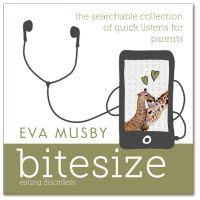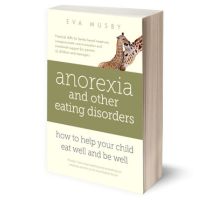When OCD co-occurs with an eating disorder
Obsessive-compulsive disorder can occur along with an eating disorder.
This overlap can be bewildering for parents, especially when it’s hard to tell what’s OCD and what’s the eating disorder. And perhaps you found this page after being passed between specialists for each condition, when what you want is support that treats your child as a whole.
Here, I share some notes to help you with your learning and research. There isn't yet a single, well-established method for treating both disorders together. This could be a good thing, as it could mean treatment will be individualised to your child's presentation.
Compulsive behaviours
We tend to think of OCD as a disorder of compulsive behaviours: lengthy, repetitive and ritualistic. For the person with OCD and their family, it can feel distressing and time-consuming. It can get in the way of life.
But that's not the whole picture…
Intrusive thoughts
OCD might not involve any visible behaviours.
Obsessions are also part of OCD in the DSM diagnostic manual. Obsessions are recurrent and persistent thoughts — intrusive, unwanted, and causing anxiety or distress. The person may seek constant reassurance, rather than engaging in any visible behaviour.
Note that obsessive thinking, distress and reassurance-seeking are a typical part of the eating disorder picture, and don't automatically indicate a separate OCD diagnosis.
A podcast / YouTube that brought to home to me quite how much intrusive thoughts are part of OCD (it's not about eating disorders) is: 'Therapist with OCD explains how to treat it', with Forrest Hanson interviewing Kimberly Quinlan.
Is it OCD or malnourishment?
Most of us have seen OCD signs in our children while they're malnourished. In my daughter's case, she got a fear of germs and of water at her lowest weight. This reversed in a matter of days as the hospital re-nourished her.
In my post 'Bizarre yet normal eating disorder symptoms', I describe signs that might make you think your child has a co-occurring disorder, but that are common with an eating disorder — especially once a lot of weight has been lost.
So unless your child had OCD before having an eating disorder, chances are they don't have OCD.
"Treat the eating disorder first"
If your child does have OCD as well as an eating disorder, most experts I've learned from say, 'treat the eating disorder first'. One reason is that the eating disorder is the most dangerous of the two conditions. It takes its toll on the body and we want to reverse that as quickly as possible.
Another reason is that OCD is worsened by malnutrition — partly, I guess, because malnutrition increases anxiety. Bring nutrition and weight back up, and usually, the OCD becomes less intrusive. We also know that rapid weight regain is an indicator of rapid, full eating-disorder recovery.
But I also know of young people where, after some time treating the most urgent aspects of the eating disorder, it made sense to focus on OCD.
For example, I knew of a boy who spent so long washing his hands before a meal that it was very hard to feed him. Also, his skin got sore, and he was always late for school.
Re-nourishment is tough and often distressing for our children, but this boy's misery was compounded by the level of OCD. The team decided to prioritise OCD work, while letting go of some of the intensity of the refeeding work. That turned out to be effective.
Each case will be different, and you deserve a good discussion with your treatment team.
Hopefully, your child has a treatment team with the competence to treat both OCD and the eating disorder. If you get shunted from one service to another, advocate for them.
Exposure therapy
A common treatment for OCD is exposure and response prevention (ERP).
'Exposure' means you do the thing you're scared of. 'Response prevention' means you resist using your usual (compulsive) soothing behaviour.
Over time, the nervous system learns that the feared situation is safe.
The good news is that we do similar interventions to free our children of their eating-disorder fears and rituals (see Chapter 9 of my book, as well as many audios in my Bitesize audio collection — and I do a workshop too).
So once you're familiar with the skills of exposure work, you can use them with food, restaurants, counting calories, body-checking or wiping grease off the food — without needing to over-analyze whether it's OCD or eating-disorder-related.
With OCD, this work is normally done by a therapist, with your child's willing collaboration. With an eating disorder, we've learned through Family-Based Treatment that we parents can drive progress even when our children don't see they have a problem. At age 11, my daughter's anorexia would have stuck far longer if I'd waited for her to be willing to eat chocolate brownies, have milk from a different glass, and eat in a cafe.
The inhibitory learning model in exposure therapy
There's a form of exposure therapy that rests on an 'inhibitory learning model', and I suggest this can only done by a therapist trained in the method — not for parents to do at home.
And it rests on collaboration from your child. They must willingly engage.
Lets take the example of the fear of calories. Your child might agree to eat some cake with you or with a therapist — so far, so normal. With the exposure therapy I'm familiar with, we might offer calming, reassurance or some rational thought, like 'Let's breathe', 'Don't worry, it's safe', or 'You're catastrophising — let's change your thoughts'.
We try not to reassure so much that our child depends on it, and that this in itself becomes a crutch — a 'safety behaviour'. But we do aim to reduce distress while our child is doing something brave.
But with the 'inhibitory learning model', the therapist wants the person to really feel the fear.
That way the person will experience that fear doesn't do any harm, that it subsides, that the feeling is OK. Their confidence and willingness to challenge themselves will grow. And they'll also get the habituation — the brain rewiring — that the usual ERP method produces.
So with the inhibitory learning model, a therapist might say, 'Gosh, you'll totally gain weight if you eat all of that'.
You can see why it's a 'Don't try this at home' approach! And why it needs the patient's buy-in: they know why the therapist is being so provocative.
Watch webinar 'Treating OCD and Eating Disorders' with Cheri Levinson. While the talk is about exposure in general, and doesn't offer much specific to OCD, the handout (available from F.E.A.S.T here) is full of examples of the inhibitory learning model.
This self-help book and this clinician's manual, by Waller, Becker and Farrell, describe exposure therapy based on the inhibitory learning model. They're only for eating disorders, but I believe the methods come from OCD research.
I say more about these books here. Parents, you'll learn plenty from them, but remember they start from a position where the person with an eating disorder is able and willing to engage.
Conclusion
Take heart — both eating disorders and OCD can both be treated, and in most cases, as you help your child recover from the eating disorder, the OCD naturally softens. I have lots of resources to guide you through that process.
Onwards
* Read similar points from a researcher and clinician: Riccardo Dalle Grave on Anorexia Nervosa and Obsessive-Compulsive Disorder: How to tell when they really coexist? *
* A study indicating that systemic family therapy may be more effective than Family-Based Treatment for patients with strong obsessive-compulsive symptoms: Agras et al (2014), ‘Comparison of 2 Family Therapies for Adolescent Anorexia Nervosa. A Randomized Parallel Trial’.
* Chapter 9 of my book: Free your child of fears and rules with exposure *
* My Bitesize audio collection *
* Bizarre yet normal eating disorder symptoms *
* ADHD with an eating disorder: tips to help your child *
* Autism and eating disorders: individualising treatment for your autistic child or teen *
* How to calm your child when the eating disorder heightens anxiety and panic *
* How do you get your child to eat? *
* For OCD and other anxiety disorders, you may enjoy Christopher McCurry, ‘Parenting Your Anxious Child with Mindfulness and Acceptance: A Powerful New Approach to Overcoming Fear, Panic, and Worry Using Acceptance and Commitment Therapy’’.
Even without OCD in the picture, this book is highly relevant to the work of refeeding our children and exposing them to fear foods. Well worth reading. *









LEAVE A COMMENT (parents, use a nickname)